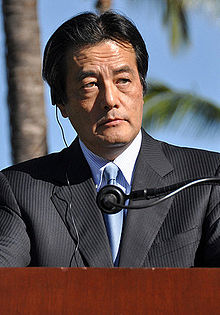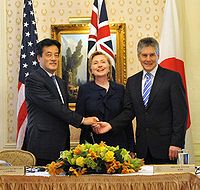- Katsuya Okada
-
Katsuya Okada
岡田 克也
Minister for Foreign Affairs In office
16 September 2009 – 17 September 2010Prime Minister Yukio Hatoyama
Naoto KanPreceded by Hirofumi Nakasone Succeeded by Seiji Maehara Personal details Born 14 July 1953
Yokkaichi, JapanPolitical party Democratic Party (1998–present) Other political
affiliationsLiberal Democratic Party (Before 1994)
New Frontier Party (1994–1996)
Sun Party (1996–1998)
Good Governance Party (1998)Alma mater University of Tokyo
Weatherhead Center for International AffairsProfession Lawyer Website Official website Katsuya Okada (岡田 克也 Okada Katsuya, born July 14, 1953) is a Japanese politician. A member of the House of Representatives of Japan, he is Secretary-General of the Democratic Party of Japan (DPJ) and was previously its President. From September 2009 to September 2010, he was Foreign Minister of Japan.[1]
Contents
Early life and family
Okada is the second son of Takuya Okada, who is a founder of Japanese retail giant AEON Group.[2] His elder brother, Motoya Okada is the President and CEO of AEON Group. He has a younger brother and a half-sister. A native of Yokkaichi, Mie, Okada graduated from the University of Tokyo with a degree in law, and entered the Ministry of International Trade and Industry. He also studied at Weatherhead Centre for International Affairs in Harvard University.[3]
Political career
Okada ran for the House of Representatives at the 1990 general election from LDP, representing Mie Prefecture's third district, and later joined the Takeshita faction of the Liberal Democratic Party, and followed faction leaders Tsutomu Hata and Ichirō Ozawa to join the Japan Renewal Party in 1993.[2] Through a series of splits and mergers, Okada then became a member of the Shinshinto, Sun Party, and Minseito, finally entering the DPJ upon its merger with Minseito in 1998.[2]
He became president of the DPJ on May 18, 2004, and led the DPJ to one of its largest electoral victories in history during the 2004 House of Councillors election. However, he resigned after his party suffered dramatic losses in the September 2005 general election.[4]
Okada ran for the presidency in 2009 but lost to Yukio Hatoyama. Following the success of the Democratic Party of Japan in the 2009 general election, Hatoyama selected Okada to be the Foreign Minister.[5]
Okada was regarded as a possible successor of Hatoyama when Hatoyama announced his resignation as Prime Minister and DPJ leader in June 2010,[6] but Okada gave his support to Finance Minister Naoto Kan, who quickly emerged as the likely successor to Hatoyama. Ichirō Ozawa, however, whose resignation had also been reported announced by Hatoyama, was still supporting another less well known possible successor, Shinji Tarutoko, 50, a legislator who leads the environmental policy committee in the lower house of Parliament, a day before the DPJ leadership elections.[7] After being selected as the new prime minister, Kan reaffirmed Okada as foreign minister.[8]
As foreign minister, Okada was one of the chief participants in negotiations with the United States (US) over the relocation of Marine Corps Air Station Futenma on Okinawa. The Foreign Ministry under Okada also confirmed the existence of a long-rumored secret pact between Japan and US which had allowed the US military to carry nuclear weapons into Japanese territory in contravention of the Treaty of Mutual Cooperation and Security between the United States and Japan. The previous administration under the LDP had denied that such a pact existed.[8]
In a September 2010 cabinet reshuffle, Okada was moved from Foreign Minister to Secretary General of the DPJ.[9] Okada, who is viewed as an intraparty ally of Prime Minister Naoto Kan, is believed to have been given the role of Secretary General in order to secure Kan's influence in the governing party,[10] as well as to help force the passage of government bills in parliament.[11]
Other interests
Okada is said to be an avid collector of frog knick knacks, which decorate his office.[5]
References
- ^ Hatoyama starts naming Cabinet minister candidates. Mainichi Shimbun. September 5, 2009.
- ^ a b c Profile: Katsuya Okada. BBC News. September 8, 2005
- ^ Centrepiece: Newsletter of the Weatherhead Center for International Affairs at Harvard University. 23 (1), 2008.
- ^ Koizumi Clinches Historic Election Victory. The Seoul Times. September 11, 2005.
- ^ a b Nishikawa, Yoko; Sieg, Linda; Roddy, Michael (September 5, 2009). Key facts about Okada, to be Japan foreign minister. Reuters.
- ^ "Japan’s Premier Will Quit as Approval Plummets", by Martin Fackler, The New York Times, June 1, 2010. Retrieved 2010-06-02.
- ^ "Finance Chief Favored as Next Japanese Leader", by Martin Fackler, The New York Times, June 3, 2010. Retrieved 2010-06-03.
- ^ a b Japan Times, "Cabinet Profiles: Kan's lineup", June 9, 2010, p. 4.
- ^ "Kan replaces over half of his Cabinet". Kyodo News. 2010-09-17. http://search.japantimes.co.jp/cgi-bin/nn20100917x2.html. Retrieved 2010-09-17.
- ^ "Prime minister makes bold move in shutting out Ozawa's influence". The Japan Times. 2010-09-17. http://search.japantimes.co.jp/cgi-bin/nn20100917x3.html. Retrieved 2010-09-17.
- ^ "Japan’s Premier Shuffles Cabinet". The New York Times. 2010-09-17. http://www.nytimes.com/2010/09/18/world/asia/18japan.html. Retrieved 2010-09-17.
External links
- Official website for Okada
Party political offices Preceded by
Yukio EdanoSecretary General of the Democratic Party of Japan
September 2010-Incumbent Preceded by
Yukio HatoyamaSecretary General of the Democratic Party
2009Succeeded by
Ichirō OzawaPreceded by
Naoto KanLeader of the Democratic Party
2004–2005Succeeded by
Seiji MaeharaPreceded by
Kansei NakanoSecretary General of the Democratic Party
2002–2004Succeeded by
Hirohisa FujiiPreceded by
Naoto KanPolicy Affairs Research Council Chairman of the Democratic Party
2000–2002Succeeded by
Banri KaiedaPolitical offices Preceded by
Hirofumi NakasoneMinister for Foreign Affairs
2009–2010Succeeded by
Seiji MaeharaHouse of Representatives of Japan Preceded by
Jirō Kawasaki
Sachio Yamamoto
Masayasu Kitagawa
Chikara Sakaguchi
Chūji ItōRepresentative for Mie 1st district
1990–1996
Served alongside: Chūji Itō, Masayasu Kitagawa, Jirō Kawasaki, Hiroshi Nakai, Chikara SakaguchiDistrict eliminated New district Representative for Mie 3rd district (single-member)
1996–Incumbent Foreign Ministers of Japan Inoue · Itō · Ōkuma (1st) · Aoki (1st) · Enomoto · Mutsu · Saionji (1st) · Ōkuma (2nd) · Nishi · Ōkuma (3rd) · Aoki (2nd) · Katō (1st) · Sone · Komura (1st) · Katō (2nd) · Saionji (2nd) · T. Hayashi · Terauchi (1st) · Komura (2nd) · Uchida (1st) · Katsura · Katō (3rd) · Makino · Katō (4th) · Ōkuma (4th) · Ishii · Terauchi (2nd) · Motono · Gotō · Uchida (2nd) · Yamamoto · Ijuin · Matsui · Shidehara (1st) · G. Tanaka · Shidehara (2nd) · Inukai · Yoshizawa · Uchida (4th) · Saitō · Hiroda · Arita · S. Hayashi · N. Satō · Hirota · Ugaki · Arita · N. Abe · K. Nomura · Arita · Matsuoka · Toyoda · S. Tōgō (1st) · Tōjō · Tani · Shigemitsu (1st) · S. Tōgō (2nd) · Shigemitsu (2nd) · K. Suzuki · Yoshida (1st) · Ashida · Yoshida (2nd) · Shigemitsu (3rd) · Kishi · Fujiyama · Kosaka · Ōhira · Shiina · Miki · Aichi · Fukuda · Ōhira · Kimura · Miyazawa · Kosaka · Hatoyama · Sonoda · Okita · M. Ito · Sonoda · Sakurauchi · S. Abe · Kuranari · Uno · Mitsuzuka · Nakayama · Watanabe · Mutō · Hata · Kakizawa · Kono (1st) · Ikeda · Obuchi · Kōmura (1st) · Kono (2nd) · M. Tanaka · Koizumi · Kawaguchi · Machimura (1st) · Aso · Machimura (2nd) · Kōmura (2nd) · Nakasone · Okada · Maehara · Matsumoto · Genba
Categories:- 1953 births
- ÆON Group
- Foreign ministers of Japan
- Government ministers of Japan
- Living people
- Members of the House of Representatives of Japan
- People from Yokkaichi
- Liberal Democratic Party (Japan) politicians
- New Frontier Party politicians
- Sun Party politicians
- Good Governance Party politicians
- Democratic Party of Japan politicians
Wikimedia Foundation. 2010.

